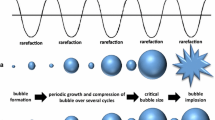Abstract
Introduction
It has been shown that killing of suspended cells by low-intensity ultrasound (0.08–0.11 W/cm2) can be enhanced by a mild non-lethal hypotonic (146 mOsm) medium.
Purpose
In this study we wished to determine whether hypotonia-induced cell swelling of suspension cells was directly related to enhancement of ultrasound-mediated cell killing, and to verify whether similar effects could be observed on circulating and attached cells.
Methods
U937 cells under mild hypotonia were exposed to ultrasound for different times with real-time monitoring of cell size using a particle-size-distribution analyzer. To study the effect on attached cells, HeLa cells were exposed to ultrasound while under hypotonia in an in vivo-simulated set-up.
Results
The result showed that the enhanced cell killing (up to more than twice) was directly proportional to hypotonia-induced cell swelling. Similar membrane damage based on PI staining could be observed on HeLa cells treated with hypotonia. An in vivo-simulated circulating system also showed similar findings for hypotonia-enhanced ultrasound cell killing.
Conclusion
These findings showed that mild hypotonia can be used to augment the effect of ultrasound in the treatment of cancers, particularly leukemia. The results showing that such enhancement is related to cell swelling could guide us toward proper timing of sonication while under hypotonic treatment.




Similar content being viewed by others
References
Ho SN. Intracellular water homeostasis and the mammalian cellular osmotic stress response. J Cell Physiol. 2006;206(1):9–15.
Feril LB Jr, Kondo T, Takaya K, Riesz P. Enhanced ultrasound-induced apoptosis and cell lysis by a hypotonic medium. Int J Radiat Biol. 2004;80(2):165–75.
Miller MW, Battaglia LF, Mazza S. Biological and environmental factors affecting ultrasound-induced hemolysis in vitro: medium tonicity. Ultrasound Med Biol. 2003;29(5):713–24.
Feril LB Jr, Kondo T, Zhao QL, Ogawa R. Enhancement of hyperthermia-induced apoptosis by non-thermal effects of ultrasound. Cancer Lett. 2002;178(1):63–70.
Cui ZG, Kondo T, Feril LB Jr, Waki K, Inanami O, Kuwabara M. Effects of antioxidants on X-ray- or hyperthermia-induced apoptosis in human lymphoma U937 cells. Apoptosis. 2004;9(6):757–63.
Feril LB Jr, Kondo T, Cui ZG, Tabuchi Y, Zhao QL, Ando H, et al. Apoptosis induced by the sonomechanical effects of low intensity pulsed ultrasound in a human leukemia cell line. Cancer Lett. 2005;221(2):145–52.
Larkin J, Soden D, Collins C, Tangney M, Preston JM, Russell LJ, et al. Combined electric field and ultrasound therapy as a novel anti-tumour treatment. Eur J Cancer. 2005;41(9):1339–48.
Feril LB Jr, Kondo T, Umemura S, Tachibana K, Manalo AH, Riesz P. Sound waves and antineoplastic drugs: the possibility of an enhanced combined anticancer therapy. J Med Ultrason. 2002;29:173–87.
Feril LB Jr, Kondo T. Biological effects of low intensity ultrasound: the mechanism involved, and its implications on therapy and on biosafety of ultrasound. J Radiat Res. 2004;45(4):479–89.
van Heerde WL, Robert-Offerman S, Dumont E, Hofstra L, Doevendans PA, Smits JF, et al. Markers of apoptosis in cardiovascular tissues: focus on annexin V. Cardiovasc Res. 2000;45(3):549–59.
Riesz P, Kondo T. Free radical formation induced by ultrasound and its biological implications. Free Radic Biol Med. 1992;13(3):247–70.
Nyborg WL. Biological effects of ultrasound: development of safety guidelines. Part II: general review. Ultrasound Med Biol. 2001;27(3):301–33.
Madersbacher S, Kratzik C, Susani M, Pedevilla M, Marberger M. Transcutaneous high-intensity focused ultrasound and irradiation: an organ-preserving treatment of cancer in a solitary testis. Eur Urol. 1998;33(2):195–201.
Vaezy S, Martin R, Crum L. High intensity focused ultrasound: a method of hemostasis. Echocardiography. 2001;18(4):309–15.
Zderic V, Keshavarzi A, Noble ML, Paun M, Sharar SR, Crum LA, et al. Hemorrhage control in arteries using high-intensity focused ultrasound: a survival study. Ultrasonics. 2006;44(1):46–53.
Vaezy S, Martin R, Yaziji H, Kaczkowski P, Keilman G, Carter S, et al. Hemostasis of punctured blood vessels using high-intensity focused ultrasound. Ultrasound Med Biol. 1998;24(6):903–10.
Ogawa R, Kagiya G, Feril LB Jr, Nakaya N, Nozaki T, Fuse H, et al. Ultrasound mediated intravesical transfection enhanced by treatment with lidocaine or heat. J Urol. 2004;172(4 Pt 1):1469–73.
Taniyama Y, Tachibana K, Hiraoka K, Namba T, Yamasaki K, Hashiya N, et al. Local delivery of plasmid DNA into rat carotid artery using ultrasound. Circulation. 2002;105(10):1233–9.
Feril LB Jr, Ogawa R, Tachibana K, Kondo T. Optimized ultrasound-mediated gene transfection in cancer cells. Cancer Sci. 2006;97(10):1111–4.
Ben-Sasson S, Shaviv R, Bentwich Z, Slavin S, Doljanski F. Osmotic behavior of normal and leukemic lymphocytes. Blood. 1975;46(6):891–9.
Karalias N, Inglessis N, Karabetsos Y, Kranidiotis A, Thomopoulos D. Osmotic fragility of peripheral blood lymphocytes in some lymphoproliferative disorders. Acta Haematol. 1984;72(2):138–9.
Lagneaux L, de Meulenaer EC, Delforge A, Dejeneffe M, Massy M, Moerman C, et al. Ultrasonic low-energy treatment: a novel approach to induce apoptosis in human leukemic cells. Exp Hematol. 2002;30(11):1293–301.
Lejbkowicz F, Salzberg S. Distinct sensitivity of normal and malignant cells to ultrasound in vitro. Environ Health Perspect. 1997;105(Suppl 6):1575–8.
Lejbkowicz F, Zwiran M, Salzberg S. The response of normal and malignant cells to ultrasound in vitro. Ultrasound Med Biol. 1993;19(1):75–82.
Acknowledgments
This work was supported in part by a Grant-in-Aid for Scientific Research on Priority Areas (18800075 and 20500432) from the Ministry of Education, Culture, Sports, Science and Technology, Japan, and also in part by a grant from Fukuoka University Central Research Institute. We would like also to thank Mr Yasser Ilich F. Loayon for assisting with some of the experiments.
Author information
Authors and Affiliations
Corresponding author
About this article
Cite this article
Feril, L.B., Tachibana, K., Kondo, T. et al. Hypotonia-induced cell swelling enhances ultrasound-induced mechanical damage to cancer cells. J Med Ultrasonics 37, 3–8 (2010). https://doi.org/10.1007/s10396-009-0241-3
Received:
Accepted:
Published:
Issue Date:
DOI: https://doi.org/10.1007/s10396-009-0241-3




